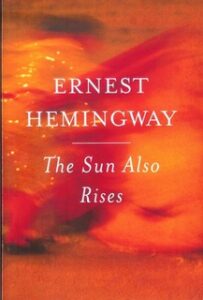
The Sun Also Rises
By Ernest Hemingway
Originally published 1926
272 pages
This was Hemingway’s first novel. And I think it’s a very good one.
Plot
It’s the story of a small group of 20-something British and American expats traveling from Paris to Pamplona several years after WWI. Jake, the main character, is a writer, an outdoorsman, a bullfighting aficionado, a heavy drinker, a war veteran, and a romantic. (Who does that sound like?) He’s in love with Lady Brett Ashley, with whom just about every other character in the novel is in love with. Jake has certain advantages in this contest, as Brett is attracted to manly men. But he has one significant disadvantage: He’s been rendered impotent (or so it seems) from a war wound. Thus, Jake spends most of the story in her periphery, watching her have affairs with acquaintances and friends.
If you know anything about Hemingway, it will be difficult to read this without seeing it as a roman à clef. You’ll want to guess who the other characters are modeled on. (And there’s plenty of research to read about that.) It will also make you wonder if the speculations about Hemingway’s sexual preferences might be true.
But it’s more than a roman à clef. It’s also a travelog, a period piece, and a portrait of the artist as a young man. Which could have been a bit of biting off more than this young writer was able to chew. But it manages to do that and more. It’s also about finding meaning in one’s life after the innocence of youth has been eradicated by experience.
Theme
That bit I just mentioned about the loss of innocence and the search for meaning has been characterized by some critics as the emblematic chronicle of what Gertrude Stein called “The Lost Generation” – the rejection by the writers and artists who fought in WWI of traditional European and American values and their struggle to feel comfortable reinstalling themselves in the quotidian lives of their fellow countrymen that were protected from the horrors of that war.
Critical Reception
The Sun Also Rises received mixed reviews when it was first published. One of the problems some critics had with it was that although the story was tragic, the protagonist wasn’t heroic. And the ending was neither triumphant nor tragic. (This was beautifully captured at the end of the novel when Brett says to Jake that had things been different, they could have had “a damned good time together.” Jake’s response, the last line of the novel: “Wouldn’t it be pretty to think so?”)
Critics no longer feel that way. In fact, it could be argued that The Sun Also Rises led the way for what some call the modern tragedy.
Another problem some critics had with it was Hemingway’s literary style – the understatement, the pared down sentimentality, the presentation of images and scenes without explanations. Like the treatment of the story, Hemingway’s writing style (most of which he was tutored in by Gertrude Stein and Ezra Pound) became the literary standard of American prose.
Today, The Sun also Rises is regarded as one of Hemingway’s best books, and one of the best American novels ever written.
